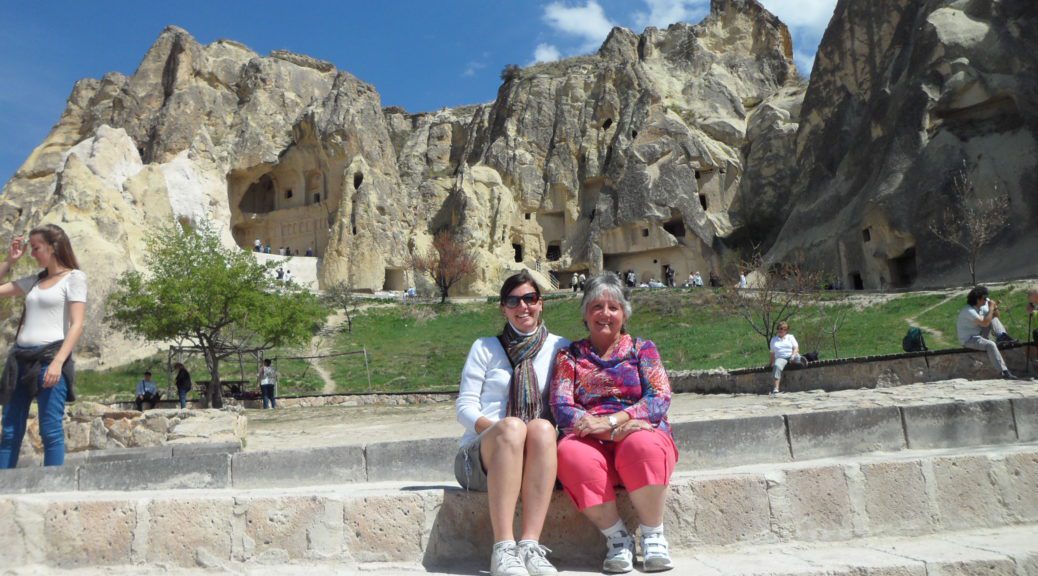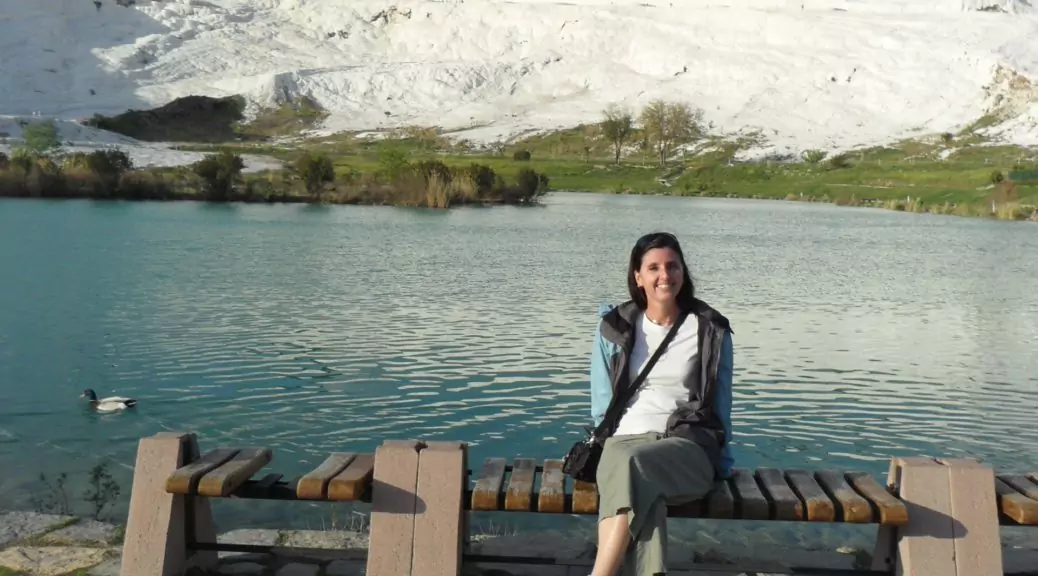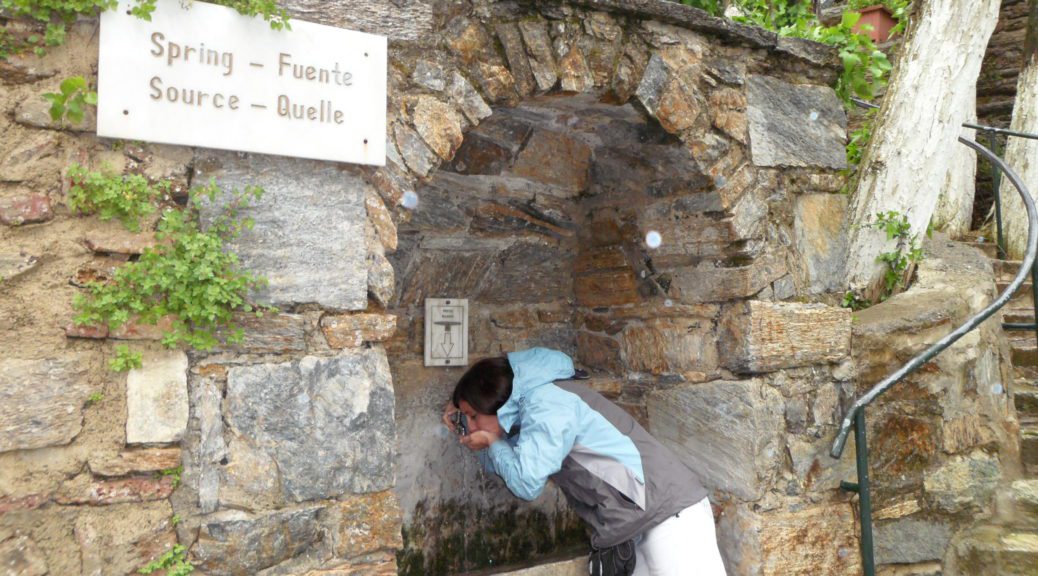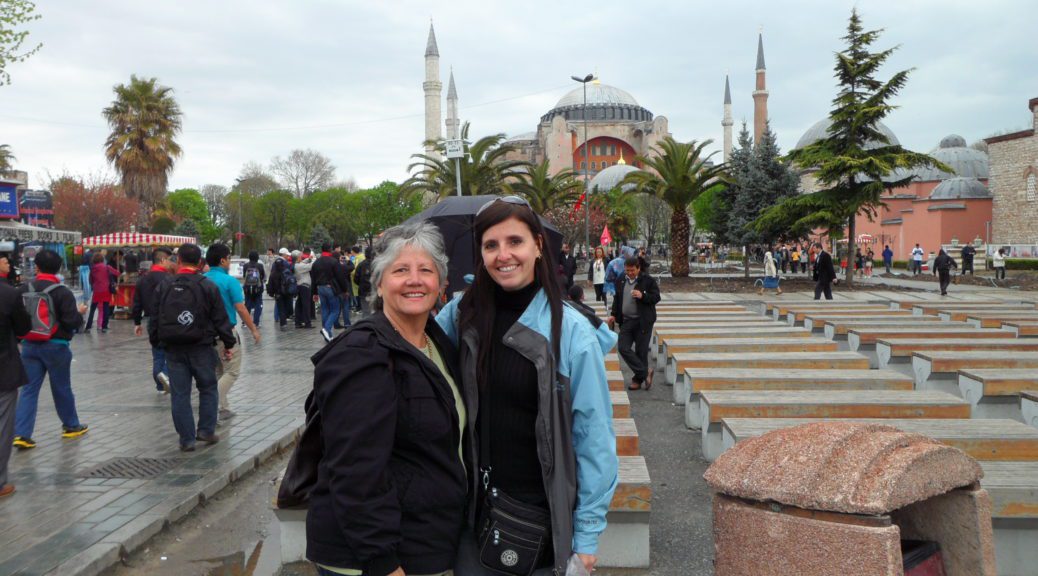CAPADOCCIA
20-21 April 2012
After a blissfully easy overnight bus trip from Pamukkale, we arrived at the terminus in Capadoccia at 7-ish. We were ushered off the bus, given our luggage, herded around and then loaded back onto the bus. (By ‘we’ I mean me, Mother and our 4 Argentinian friends, who spoke little to no English, were clearly bewildered by the goings on and were nervously chattering and gesturing among themselves at ten to the dozen, which was hopefully cathartic because it wasn’t even vaguely useful). Turns out that we’d arrived at the main terminus when we were supposed to meet our tour a few stops later on.
This sounded plausible as we’d become more than used to having to figure out our own way on our ‘all-in guided tour’, which had us melding and blending with other people at each stop along the way as our paths overlapped, relying on our own itineraries printed at home to get instructions of varying degrees of vagueness in Turglish from conductors, drivers and guides.
Minutes later we were again deposited, this time in a lovely little village in a valley bowl ring-fenced by sandy-coloured rock formation cliffs. The bus stop was a parking lot on a side road parallel to the main road, with the town’s tourist office on the left, a short strip mall of tour sales offices on the right and scores of hot air balloons overhead (this area is particularly known for its hot air ballooning because of the spectacular aerial views of the landscape).
It was fortunate that the view and ambiance was lovely because we had absolutely no clue where we were or where we were going.
Out (again) with trusty itinerary.
No clues.
Uh-oh.
We approached the tourist office, asking them to contact our tour company in Istanbul to find out who was supposed to be meeting us, but they couldn’t help because their telephones could only access numbers on the local exchange.
We eventually came right by getting one of the sales guys from the tour offices to call our Tour Operator – after a lengthy negotiation with him trying to sell us a hot air balloon ride for the next morning (they are a ‘mornings only’ thing), which would have been tempting had it not been for the fact that we would be in Istanbul the next morning… which the salesman was not readily accepting. Adnan in Istanbul told salesguy to tell us to stay put and he’d get our guide to come and find him.
Minutes later (just enough time for a ‘lick and a promise’ – as Grammy used to say – and a change of clothes in the public bathrooms) we were fetched by our local tour operator, complete with the area manager, a delightful and enthusiastic fellow called Sam, who insisted on taking us back to their new offices, which were quite something as they were built into the rock, so essentially had a brick face and a cave back.
He was quite excited to find out it was Mother’s birthday (and her milestone 60th, no less!) and scuttled off to forage for breakfast for us, leaving us in the company of our guide for the day, Hamida (whose nickname is Happy Day since it sounds so similar to the pronunciation of her name and matches her sunny disposition).
Sam returned with Burek, pie-like savoury treats that have a variety of fillings folded into layers of feather-light pastry, with a smattering of seeds (sesame, poppy etc) on top to indicate the flavour enveloped inside. Sam has brought cheese, mince and potato. Too big for one of each, but too intriguing to miss out on any flavour, Mother and I shared one of each. Highly recommendable!
Fed and satisfied, we were ushered to the mini-bus to go and collect the rest of the group, which as it turned out were only expecting us at 10am so we were perfectly to time despite all our detouring. Another patchwork of a trio here and a couple there.
We wound around and about through the town (Urgup, as we now knew was where we should have stopped in the first place) as our guide told us bits and bobs of trivia about this place, which has been around almost since time began so there was lots to tell).
Capadoccia (Cup–uh-doh-kia) is more or less in the middle of Turkey, in Eastern Anatolia, easily accessible from the major city Kayseri to the northeast, which has an airport and railway station service to Ankara and Istanbul bringing the scores of tourists that come to see the unique geological, historic and cultural features. The name translates back to the “Land of beautiful horses” since ancient Capadoccia was known for horse breeding.
Even before that, even-more-ancient volcanoes erupted 3 – 9 million years ago, forming the ignimbrite deposits and sedimentary rocks in lakes and streams. A soft ‘tuff’ layer was formed, 150m in thickness, by the issuing lavas in the valley surrounded by mountains. The rivers, floodwater running down the hillsides of valleys and strong winds eroded the geological formations into hundreds of spectacular pillars and minaret-like forms. People of the villages at the heart of the Cappadocia Region carved out houses, churches, and monasteries from the soft rocks of volcanic deposits, the best of which can still be seen at Goreme (which we’ll get to later).
Capaddocia lies on a high plateau, 1000m in altitude, punctuated with volcanic peaks that reach to almost 4000m. Because of the inland location and high altitude, the region has a markedly continental climate with hot dry summers and cold snowy winters, sparse rainfall and semi-arid. And yet still it is a wine region. One of the few areas in the very Muslim country that isn’t required to be tee-total (probably a hangover from the Greek regime since the Turks only settled in the Middle Ages in this area that was Hellenised for millennia before that), which is lucky since it produces some world-renowned award-winning wines.
These temperatures also made for interesting storage and insulation challenges. We passed little peepholes in the rocks that we were told were windows and vents for underground / cave storage, where people for thousands of years have been able to keep fruits and meats stocked ‘at room temperature’ without any machine assistance. The rocks are also used in producing slates and tiles for house-building, since their amazing insulation characteristics somehow manage to keep houses cool enough in searing summer and warm enough in icy winter without the aid of any heaters or fans!
Well primed on the region, we made our first stop at the Fairy Chimneys. Bizarre rock formations eroded over time into mushroom-shaped, pinnacled, capped and conic shapes. We took a short trek through a collection of the formations, each pointing out shapes that we could see in rocks or collections of rocks. Crocodile, lions, Godzilla, ugly old crone etc etc. I saw Dachshunds. Obviously.
In between the rock-spotting we were shown doors and windows high up on the minarets, some with the still-visible footholes that served as ladders for the people of the time to climb to enter their rock cave homes. These caves were intentionally hidden and difficult to access as they were occupied largely by Christians trying to escape persecution. Nowadays they are easier to spot as there has been so much more erosion over time.
We visited another area with these cave homes, but this was more of a village with communal areas and homes built alongside one another on larger rock faces rather that at periodic intervals on rock spires (think of it as a townhouse complex versus stand-alone country houses).
This village had some interesting features, like the bee-keeping caves. These were caves carved into the rock face housing boxes in which the bees would create hives and produce honey. There were enclaves big enough for people to go up into the cave and harvest the honey as and when needed.
After some time to wander around the caves, entering into the ‘apartments’ and seeing how much these people were able to ‘furnish’ by carving things that they needed out of the rocks, it was off to shop at the market… and buy a lovely locally produced stripy pashmina (silk/pashmina blend for a bargain R40).
Every tour is punctuated with the inevitable sales pitch, and this was next on the agenda. We were to stop off at the pottery factory and winery.
We were served wine on arrival. Clearly not the award-winning stuff either. Very… erm… tart. The pottery-making was fun to watch though, but not to buy apparently since the shop had mostly very high-end collectors pieces for thousands of Lira / Rands / Dollars. Hardly surprising since each piece is painstakingly hand-painted by a team of artists (one to do the outlines, another to colour, another to glaze).
Well set for an early lunch, we arrived at Suhan Hotel and Spa for a very fancy buffet feast – perfectly suited for a special occasion such as Mother’s 60th birthday! We ate our fill and drank our toasts and then set off again for more of the wonders of this ancient world.
Next on the tour was the World Heritage Site, Goreme Open Air Museum, which is the most visited of the monastic sites in Capadoccia and one of the most famous sites in Turkey. The complex contains more than 30 churches carved into the rocks, some with some beautifully preserved frescoes inside, dating back from the 9th to the 11th centuries. We were told how to identify this, that and the other from the art techniques, but the churches do become a bit samey-samey after the first few and, being a bit religiously shallow and a lot artistically challenged, I’m not strong on the detail.
More remarkable was the living arrangement in the complex. They had a very community-living orientation, with combined group kitchens and dining rooms and such. The kitchens were large rooms with dug-out areas where the round-bottomed pots would sit on the coals and there were relatively sophisticated ventilation systems allowing the smoke to be extracted from the room without telltale plumes appearing outside the caves (important since these were supposed to be secret settlements for the persecuted in hiding).
The main dining room still had its long table with benches either side, all carved directly from the rock face, easily seating 50 people or more in a single sitting, with alcove shelves carved into the walls to house candles and other dining paraphernalia. There were smaller dining rooms as well, with similar fittings, presumably for more intimate meals. Each dining room had a wine bath moulded into the floor where the grapes could be pressed, with an outflow funnel (also carved into the floor) channelling the juice into a pool from which the diners could serve their wine. Very simple and practical.
They also had literal pigeon holes carved higher up in the rocks. Each consisted of a cave with 1 human sized door and several rows of small pigeon holes by way of access. These pigeons were apparently used for courier messaging, and providing eggs and feathers. So, a post office, grocer and general store in one!
On our way back to the bus we stopped at the ice-cream wagon. There was a man in traditional dress ‘tossing’ the homemade ice-cream! Literally hoisting it out of the refrigerated cylinder on the wagon with a long metal paddle and tossing it into the air, almost like pizza-makers do with their dough. It was fascinating to watch and defied logic that creamy frozen ice-cream could take on the form of a long stringy toffee-like consistency. The method clearly works wonders though and it was undoubtedly one of the best and creamiest ice-creams we have ever tasted.
The next stop was at the base of the mountain that housed one of the ancient watchtowers that the city had on each end. There was no point in making the long trek up the mountain to the fort since it has become too unstable to enter since its soft walls have eroded over time, so we made do with taking some photos (and of course visiting the market, where Mother bought a beautiful table runner virtually for free).
The minibus then took us to a lookout point, with a breathtaking panorama overlooking the fairy chimneys and museums, with a view of the volcanoes on the horizon. We were treated to coffees and teas, with local fruit and nuts snacks… which turned into a surprise birthday party for Mother when the group proceeded to sing Happy Birthday to her in many of the assortment of our travel companions’ native languages. Sam had rejoined us and he and Hamida had even bought Mother a gift – a lovely silk scarf, which they had wrapped and everything! How sweet!
Then, the last surprise of the day. We had managed to arrange a break-away from this group (who were destined to visit – yet another – carpet factory next) to go and visit the Kaymakli Underground City!
Cappadocia contains several underground cities, largely used by early Christians as hiding places during the times of the persecution. There are 5 levels (uncovered so far) of intricate passageways and complex networks of storage, communal areas and private accommodations (rooms and ‘apartments’ that belonged to families).
Besides being a bit cold and dark, it was quite manageable to manoeuvre through the tunnels, which are only very rarely too small or low to have to stoop. The simple but effective ventilation tunnels and chimneys allow enough air to reduce the claustrophobia element, although I couldn’t imagine it was pleasant when inhabited by its thousands of occupants, with the smoke from their cooking fires and no formal ablutions facilities.
The underground cities have vast defence networks of traps throughout their many levels. These traps were very creative, including such devices as large round stones to block doors and holes in the ceiling through which the defenders may drop spears. These defence systems were mainly used against the Romans. The tunnel system also was made to have thin corridors since the Roman fighting strategy was to move in groups, which was not possible to do in the thin corridors making it easy to pick them off.
Managing to get in one last treasure in an amazing day, we found a stall selling locally mined onyx in the little market lining the road back to our waiting van. A thread of onyx beads each for an absolute bargain and we were on our way to the airport.
An unfortunate hour-long delay and a slow-moving queue with what seemed like hundreds of small Australian children (with Australian parents) made for a welcome relief when we collapsed into our aeroplane seats for the short hop back to Istanbul.
After the delays we were pleased to have pre-arranged our airport to hotel transfers and even more pleased to arrive back at our hotel (the same one as before, The Princess Old City Hotel) to drop our bags and settle in for our last night in Turkey.
We took a wander up and down our street, still a hive of activity with all the shops and restaurants open til late as they are, but soon retired back to the hotel after our long day, finishing off the day perfectly with an elaborate midnight feast picnic of all the remnants of nibblybits that we’d collected along the journey.
The morning was leisurely and we’d pre-decided that it would be dedicated to a luxurious visit to the Tarihi Vezneciler Hamami traditional Turkish Baths. What an experience! We were ushered into a wooden cubicle with thin beds lining either side of the room and served Turkish tea (a vile Cherry one this time, pity as we’d grown quite fond of the apple one) to sip on while you disrobe and drape in the traditional handmade cotton sarongs provided for the body and the hair. Then we were whisked off to the sauna to sweat, sweat and more sweat for 20 minutes before getting to the bath portion of the experience.
The Baths weren’t what I expected. I expected big indoor heated swimming pools with people wading around and socialising, like the picture painted of the Romans in such literary works as Asterix and Obelix. Not so. The Baths was a marble room with knee-high taps and ground level built-in marble basins about a metre apart along all of the walls. There were big marble blocks in the middle of the room for visitors to lie on, while being washed down by the person attending in between massage activities. The masseuse didn’t seem to hold much pomp and ceremony in the process and simply stripped down to her undies (plastic shoes), poured buckets of water over us and took each of us in turn into the massage room.
The massage was also very unique. The masseuse filled a pillow case with foam and then flicked the neck of the bag open and closed to agitate the foam such that it foamed more and started filtering through the weave of the pillow case. She then floated the foamy bag over your body, occasionally flicking it open and closed so that it lightly touched you and produced more foam. A very dreamy experience.
She then did the usual massage, working with strength on the feet and undersoles to work out tension and being more ginger with the sensitive bits. I think the Thai foot massages were better, but the foamy pillowcase thing is infinitely repeatable!
Once we were properly massaged and treated, we were taken back to the warm cabin and given more of the (dreadful) tea to enjoy while we relaxed and did a leisurely redress. All in all, a visit to a Turkish Bath is a must for travellers!
We got the driver to drop us off at the Grand Bazaar instead of our hotel so that we could get the last few things on our wishlists – and more than a few things that weren’t! I got some beautiful antique silver bracelets with marcasite and onyx detail for a few hundred Rands each – an absolute bargain for such collectors pieces! Mother got even more gifts for even more people at home, with everything so cheap the list of gift recipients easily gets out of control!
Fully laden with shopping, we again thanked our lucky stars that the tram stop is right outside the Grand Bazaar and took us to right outside our hotel.
Back to the room for the the usual panic of upping and outing, packing (and re-packing when all our newly acquired lovely things weren’t cooperating in Operation Suitcase Close), but we managed and checked out of the hotel with an hour to spare, that we decide to use wisely with a visit to our favourite restaurant, Simit Salonu. So pleased to have a last chance to enjoy the incredible Turkish food, we ordered our favourites and tucked into a lovely multi-dish meze style lunch.
Then it was back to the hotel to meet the driver for our long and unremarkable journey home. We’d seen and done so much in a short time and collected many many reasons to support the recommendation for anyone thinking of visiting Turkey to just DO IT!





